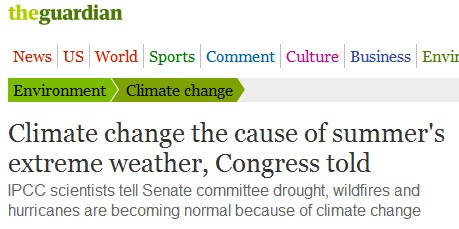Climate change the cause of summer’s extreme weather, Congress told | Environment | guardian.co.uk
The US is experiencing the lowest hurricane activity on record. It has been seven years since a major hurricane hit the US. This year is likely to have the fewest fires since 2003. Droughts were much worse in the 1930s and 1950s.
Isn’t it illegal to lie as an expert witness in a Congressional hearing?
The committee also heard from James McCarthy, a Harvard oceanographer and IPCC author, who warned that sea-level rise was occurring about three times faster than scientists believed even a decade ago.
Complete bullshit. The numbers are changing only because they are tampering with them.
Tracking The Impressive Paper Trail Of The Sea Level Fraudsters



It’s a pretty obnoxious state of affairs. I’ve been following this topic closely since 2007 and ‘extreme weather’ was not something that was discussed until recently, except very briefly. (Mainly brought on by some really cold winters in Europe.) It’s taken on a life of its own now, presumably because of the flattening of global temperature rises in the last decade or so.
You know better than that! Christopher Monckton would be doing time in Colorado if it were.
Generally, it’s not illegal to lie unless they swear you in. Rarely are witnesses sworn in, and if you are, it’s a clue that someone is out to get you. Even then, you have to get a vote of the committee, and then a vote of the entire body, before charges are recommended to the local U.S. attorney, who ignores most such recommendations, because they come about as well grounded as your claim.
OK, so it is alright for IPCC lead authors to lie in order to obtain taxpayer money via fraudulent assertions. Thanks for clearing that up.
Ha ha ha ha 🙂
No, it’s not okay to lie to get government grants. But Congress is not a granting agency, and this was not a plea for funds personally for these researchers. In fact, it’s a crime to commit fraud in a plea for funds — which is one reason so few climate denialists even bother to ask for NSF or NOAA research funding.
Ed:
They are before Congress to justify all the money they ave wasted. If it was not for the money involved there would be no reason for them to be in front of Congress.
This sham goes back to the “Dog and Pony Show” Hansen produced in 1988. It may even go back to Revelle and his Snakeoil sales job.
Mike, it was a hearing on the science — there was no intent for anyone to “justify” research monies — it was a hearing on what is the sense of science today on global warming. Chairman Boxer put it simply:
Your failure or inability to understand the legislative process, or just sheer orneryness, doesn’t change the purpose of the hearing, nor the nature of the testimony. In this case, if you claim scientists lied, bring your evidence. (What? You don’t have any? What a surprise.)
Generally, no, it’s not “okay” to lie to Congressional committees — but were it a crime, most of the people who testify in support of your wild claims on this blog would be in jail, starting with Madman Monckton. It’s difficult to tell whether Sen. Inhofe is lying or is just so ill he can’t tell the difference — but were a crime to dissemble, he’d be in difficulty, too. Inhofe has set new records in dishonesty in legislative pursuit in his unholy jihad of falsehoods on this issue, in this committee of the Senate.
You have a lot of gall to claim the guys telling the truth are, instead, liars.
The purpose of the hearing was to get on the record the science that tells the state of the art, and, in many cases, that sounds the claxons to rational people to get them to act to prevent or mitigate the damages from global warming (in Maryland, for example). If you have contrary evidence, bring it forward. Calumny does not constitute evidence.
And, by the way, witnesses at this hearing were not sworn. See the tape at about 112:30: http://epw.senate.gov/public/index.cfm?FuseAction=Hearings.LiveStream&Hearing_id=c0293eca-802a-23ad-4706-02abdbf7f7c3
Reblogged this on Climate Ponderings.
Why? Are you engaged in some odd sado-masochistic internet thing?
Here are some of the impacts of global warming, just in one state, Maryland, according to the testimony of John R. Griffin, the Secretary of the Department of Natural Resources for the State of Maryland:
Notice that this testimony informs the Committee on Environment and Public Works of the very real problems Maryland encounters. The testimony is not contested, by the way, by any researcher. It does not represent any allegations of misuse of funding. It is not testimony from any researcher with a federal grant.
Easy to sit 2,000 miles away from the committee an hurl ill-informed and surly epithets at people who work to preserve our natural resources — but shame on those who do.
lol. Fearsome “Irene”. Oh noes!